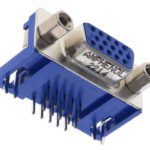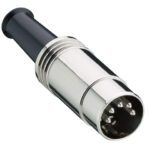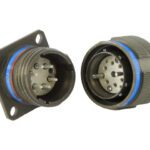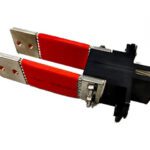What are 3D-Printed Connectors?
What are 3D-printed connectors?
Meet the Connector: 3D-Printed Connectors
From EVs to drones to autonomous robots and more, electrification is creating a demand for connectors that can be produced quickly and economically in small volumes. Suppliers are filling that need with 3D-printed connectors.
Typically, the process of manufacturing electronic connectors involves injection molding. Creating the steel molds, or tooling, is expensive and time-consuming, but when amortized over a large part run, it makes economic sense. For small runs, however, the cost becomes prohibitive. For today’s fast-changing markets, where designs are frequently being revised and updated, smaller runs are necessary for testing and to allow for adjustments before making a large commitment to a part.
3D-printing capabilities are expanding. Production-ready connectors are beginning to be available in limited quantities, and full-scale production may not be far off.
Customization and prototyping
3D-printing is often incorporated into the connector manufacturer’s prototyping process and contributes to shortening the turnaround time from 20 weeks or more (typical for manufacturing that requires a steel mold) to as little as four weeks (and sometimes even less).
“Where we found 3D printing to have the most potential value is in producing the insulators, the plastic and rubber pieces which hold the conductors,” said Matthew Simonds, R&D engineering manager at Amphenol Aerospace. “Some customers need different arrays of conductors that are not tooled-up, for example 20 small signal conductors and four large power conductors. Or they may be putting this connector on a circuit board and want the signal conductors positioned away from the power conductors to avoid signal interference. Typically, aerospace connector insulators are made with hard mold tooling that’s very expensive, and can take a year to make a mold, qualify it, and turn something new out. We knew if we could develop a 3D-printed version, we could turn out electrically functional parts in two to four weeks. So we went on a broad campaign to look at every material and printer available and come up with the closest possible thing to a standard insert that meets as many military performance requirements as possible.”

P3D-D38999 Series III from Amphenol Aerospace features 3D printed inserts.
A ‘bridge to production’
When Amphenol Aerospace asked its customers what they would use 3D-printed connectors for, the overall response was for their first prototype, not for production. As an example, a customer might be designing a ground vehicle for a U.S. Army contract that’s going to be driven into a trade show for demonstration purposes, not going to war, but needs to be completed on a tight timeline. “The 3D-printed piece is a part of our rapid prototyping engineering service,” said Simonds.
Another use is bench testing, where, for example, the customer is building a first sample cable and running electrical testing to see how things work. “Electrically, these work just as well as their production counterparts. The voltage ratings are just as high,” said Simonds.
The lab environment, however, is not the same as the field. “We found that temperature is a limitation. Connectors usually need to go to 200 °C, and we found 125 °C was pretty much the limit before you start to have problems. There are higher temperature materials available, but the tradeoff is that you don’t get the detail or the strength you need. We came up with our best stab at this, an equivalent design as close as we could get to military performance with our P3D 38999. I wouldn’t call it a product, I would call it a bridge to production. It’s a fully functional connector, with some caveats, like temperature and such.”
While you can get very good accuracy with 3D printing, some errors are possible, explained Greg Fehribach, vice president, technology strategy, transportation solutions at TE Connectivity . “You can get a scratch on a surface, you can get porosity, sometimes with a larger part you can have some tolerancing issues. We’ve developed tools in house to basically do visual inspections, using machine learning as those parts are made, to determine right away whether to keep a part or throw it away.”
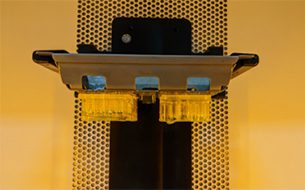
TE Connectivity 3D-printed automotive connector.
Designing for 3D printing
While it is possible to 3D print a connector model designed for injection molding, it is preferable to design specifically for 3D printing, said Fehribach. “Sand or powder can get in cavities and you have to clean it out, which adds to post-processing time. Whereas if you design it from the beginning for additive manufacturing, using the available tools and our guidelines to make your angles and cavities in such a way that, as it’s printing, the powder or liquid flows out, there’s a lot less to clean when it is completed.”
Sustainability
A number of bio-based resins and powders are coming out which contributes to 3D printing’s sustainability, Fehribach said. Additionally, he said systems can now capture any extra powder that remains after the part is made. “That powder can go back in the hopper for the next batch. With injection molding, once you melt the pellets down and inject them into the mold, you can’t just grind that up and reuse it just like it was; you have to mix it with virgin resin and only 10-20% can be recycled,” he said.

Fully assembled 3D-printed automotive connector from TE Connectivity
The future of 3D-printed connectors is now
The 3D printing of connectors is already moving “from the laboratory (the prototype area) to the shop floor,” said Ralf Klaedtke, VP/CTO of TE Connectivity Transportation Solutions. Several factors, including batch size and size of the parts, determine whether mass production is appropriate. However, Klaedtke adds, we are entering a new phase of 3D printing at industrial scale. While it is not yet widespread, the percentage is increasing every year. Time to market is a crucial motivator. Customers appreciate that they can be much faster by choosing 3D printing. In addition, generative AI is helping engineers come up with structures that can only be 3D printed.
Design Notes
- Production timeframe 3D-printing a connector can take 4 weeks (or less), compared to months (up to a year) for injection molding.
- Standardization3D printing is ideal for any type of custom connectors produced in small batches for prototyping, testing, and in some cases in final products. As quality improves, 3D printing is getting closer to producing production-quality connectors that can meet military and other standards.
- Material specifications3D-printed connectors are typically made with polymers. Some metals can be 3D printed as well. Polymers must be electrically insulating, dimensionally stable, and able to withstand high temperatures.
- Processes SLA (stereolithography) and DLP (digital light processing) are two 3D-printing processes commonly used for producing connectors.
Markets and Applications
3D-printed connectors are currently being used in a range of applications, including Military and Aerospace; Automotive prototyping; EVs, eVTOL, and drones.
Suppliers
3D-printed connectors are available from Amphenol Aerospace, Amphenol Pcd, Samtec, and TE Connectivity.
Like this article? Check out our other Meet the Connector and Networking articles, our Datacom/Telecom Market Page, and our 2023 and 2024 Article Archives.
Subscribe to our weekly e-newsletters, follow us on LinkedIn, Twitter, and Facebook, and check out our eBook archives for more applicable, expert-informed connectivity content.
- Sealing Success: Overmolding for More Secure Connections - April 23, 2024
- Medical Cable Assemblies Product Roundup - April 23, 2024
- Mezzanine Connectors Product Roundup - April 16, 2024
